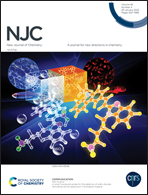A new family of 1,4-diaryl-1,3-butadiynes based on the “proton sponge”: synthesis, electronic and chemical properties†
Abstract
A new family of 1,4-diaryl-1,3-butadiynes containing two and four fragments of 1,8-bis(dimethylamino)naphthalene (DMAN or “proton sponge”) were synthesized using various 2- and 4-ethynyl derivatives of the proton sponge as synthetic building blocks in Glaser–Hay homocoupling. A significant difference in the reactivity of isomeric diynes was found. Heating 4,4′-(buta-1,3-diyne-1,4-diyl)bis(N1,N1,N8,N8-tetramethylnaphthalene-1,8-diamine) with aniline in the presence of CuCl led to heterocyclization into N-phenylpyrrole, substituted at positions 2 and 5 by the DMAN residues. Under the same conditions the 2,2′-isomer was transformed into the 2,2′-dibenzo[g]indole derivative through the nucleophilic attack of the NMe2 group on the copper-activated ortho C![[triple bond, length as m-dash]](https://www.rsc.org/images/entities/char_e002.gif) C bond and the loss of two N-methyl groups. X-Ray analysis revealed that the above 2,2′-dibenzo[g]indole exists in crystals exclusively in cisoidal conformation which is unusual for biaryls. UV/vis and CV data for the synthesized diynes have been discussed.
C bond and the loss of two N-methyl groups. X-Ray analysis revealed that the above 2,2′-dibenzo[g]indole exists in crystals exclusively in cisoidal conformation which is unusual for biaryls. UV/vis and CV data for the synthesized diynes have been discussed.



 Please wait while we load your content...
Please wait while we load your content...